This month’s Bay Island Bonsai meeting featured some of my favorite activities – evaluating bonsai and bonsai display. Boon regularly gives members opportunities to hone their understanding of judging by bringing trees for us to evaluate and having us score them. Scoring trees forces the viewer to look closely and think about a tree’s characteristics in light of specific criteria. The learning comes when we review the results as a group.
When Boon asks what score a trunk might receive on a scale of 1-10, answers range from, “I didn’t like it, I gave it a 4” to “Wow – I gave it a 10!” This gives everyone a chance to share what they do or don’t like about a particular characteristic and then learn how – and why – others respond differently. Goodness knows we don’t always come up with the same scores as each of us has different tastes, standards and understanding relating to bonsai, and that’s fine. (For more information about how Bay Island Bonsai approaches judging, see previous posts on judging.) The goal is to promote careful inspection of trees and to broaden understanding of what characteristics matter to which varieties.
For scale junipers, good movement in the trunk and deadwood are important. The trunk below is interesting and attractive, and there are plenty of full and healthy branches, though the silhouette could use some improvement.
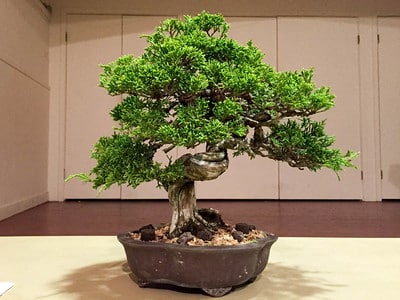
Shimpaku
At first glance the chojubai below looks full and wonderful, but upon closer inspection, it becomes clear there’s not much of a trunk and the various shoots sometimes cross at awkward angles. It’s a good start and there’s room for improvement.
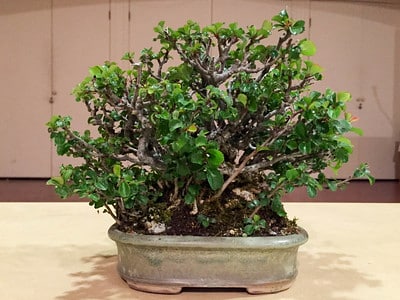
Chojubai
The black pine below is in pretty good shape. For pines, we look for good bark – a great sign of age. The silhouette is mature and the surface roots are good. This tree scored well.
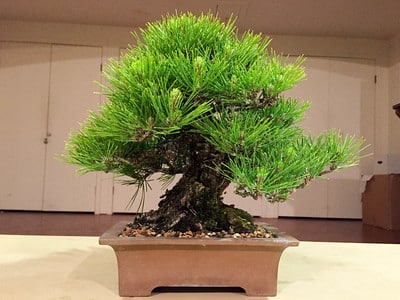
Black pine
Although it’s hard to see in the photo below, this Japanese maple has a nice trunk.
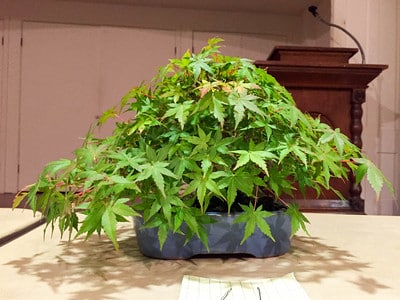
Japanese maple
The procumbens below has good movement and a full silhouette, though the foliage is currently fuller near the apex than it is at the lowest branch – time for some thinning to restore balance. This tree also scored well.
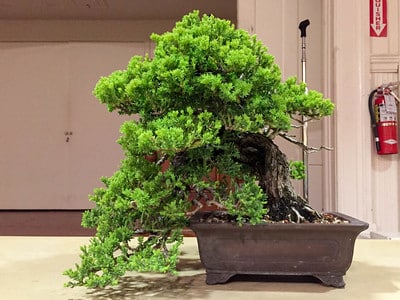
Procumbens juniper
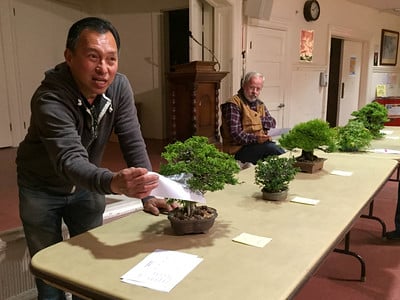
Boon making a suggestion to remove the first branch
After the judging, we turned our attention to display. Each month members bring trees to be displayed at the upcoming exhibit and we practice setting up displays with the material on hand.
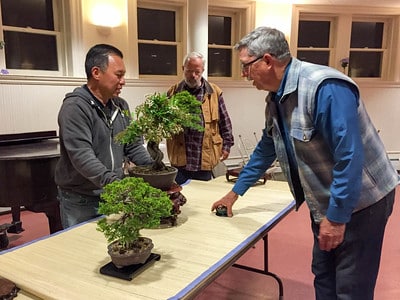
Adjusting the display
The set-up below features a pyracantha and the procumbens juniper pictured above.
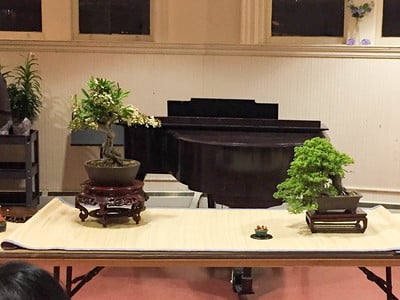
Final display
The pyracantha is being considered for exhibit as it’s covered with flowers – a good sign that fruit may be on the way.
Subscribe to Bonsai Tonight
New Posts Delivered Every Tuesday and Friday
CT Holcomb says
I would be very interested in the previous post on judging, I have been working on a rubric for judging for our club. The line link cycles back to this post. Thanks Tom
>
Jonas Dupuich says
Hi Tom, thanks for the note – try scrolling down, the link points to all posts tagged “judging.”
Alex V says
I think my favorite aspect of the judging is that it allows one to distinguish between quality of a bonsai or display, and personal taste. The first couple times I participated in this I wasn’t able to distinguish between quality trees, and trees I liked. After a few times doing it, it became easier to spot the signs of quality in a tree, even if it wasn’t to my own personal taste.
nelibonsai says
I always break down a tree into elements, and then look at the relationship of the elements. Basically that is what matters for me in my personal taste. So it is hard for me to distinguish between personal taste and quality of the tree, unless a tree evokes emotions which I consider a plus.